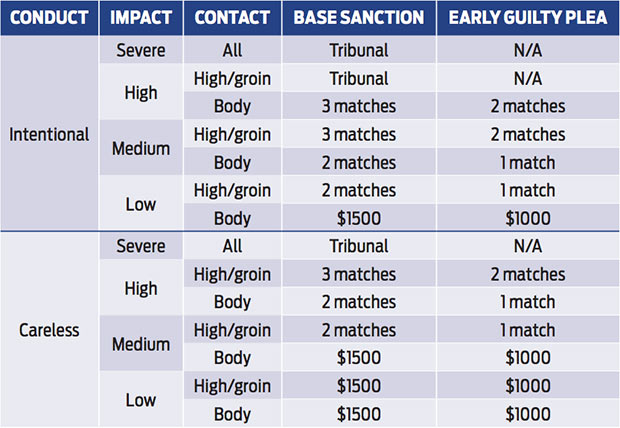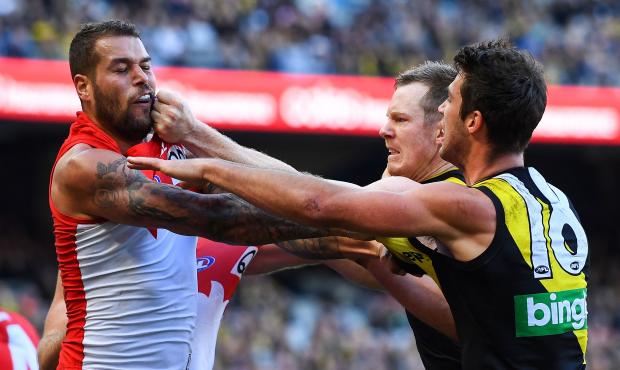ON MONDAY, an all-star cast featured on the AFL Match Review Panel's running sheet.
Among the 20 acts to be debated were incidents involving Joel Selwood, Lance Franklin, Sam Mitchell, Nick Riewoldt, Alex Rance, Luke Shuey and Dale Thomas.
All had been the subject of headlines, replays, discussion, opinion and analysis in the 80-odd hours that passed between the first game of the round last Thursday night in Perth and the MRP sitting at AFL House at Docklands.
But the big names under the microscope were not the only fascinating stories of the day.
Out of nowhere came a suspension for Sydney's Zak Jones, done for striking Richmond's Dan Butler off the ball after an eagle-eyed MRP member spotted the incident on game day.
But more on that later.
To understand how the MRP operates, it's necessary to know that most decisions are based on where an action sits in a table in the AFL's Tribunal Guidelines (see below).
Although dry, it should be mandatory reading for anyone commenting on MRP decisions, with determinations around intent (intentional or careless), impact (low, medium, high or severe) and where contact was made (high/groin or body) forming the critical axis on which decisions and outcomes swing.

Take the Shuey bump on Dangerfield, for example.
The pub talk was that Shuey had run past the ball, electing to bump and hit Dangerfield in the head. He was, according to most, in trouble.
As the vision rolled, the conversation between panel members instantly corrected some of the myths surrounding such incidents.
For instance, Shuey was entitled to bump, as the ball was within five metres – regardless of whether he had run past the ball – so there was no problem with bumping being his intention.
Therefore, the action had to be, in the view of the panel, classified as careless. To grade an action intentional, the MRP must be satisfied the player intended to commit a reportable offence.
That explains why it's very rare for a player's bump to be classified as intentional.
In the flash of an eye, the bump was categorised as careless and high, ensuring the only task left for the panel was assessing impact.
It doesn't take long, after hearing the medical report and watching Dangerfield in action soon after taking the hit, to classify the impact as low.
From that point, based on the table guidelines, the penalty is straightforward: a fine that begins at $1500 and ends at $1000, once Shuey's record is examined.
All that is needed now is for Shuey to accept the decision, which he later does.
Patrick Dangerfield received a free kick following this bump from Luke Shuey. #AFLEaglesCats pic.twitter.com/4uHINNYYr4
— AFL (@AFL) June 15, 2017
And on the panel moves to the Selwood-Mitchell matter.
The vision rolls from several different angles for the five panel members with 1143 games experience between them.
As one panel member said after watching the incident several times: "One angle is bad; the other one tells the real story."
The camera angle the panel determined showed the real story was slowed down and showed Selwood's palms being the first point of contact into the top of Mitchell's back after he tripped over his feet.
It is more illuminating than the broadcast vision most punters watched in the three days before judgment was passed.
WATCH: Selwood and Mitchell in the spotlight
"He (Selwood) was always going to land in the middle of his back. The first action is hands on the middle of his back and then he makes him earn it," a panel member said.
At the MRP's discretion, the action is changed from striking to rough conduct.
Further viewing creates more debate, as the MRP was clearly uncomfortable with Selwood's action.
"It's not a good action, let's be honest," a panel member said.
The debate must, however, centre around whether the act was intentional or careless, rather than whether it was good or bad.
"He is a talented enough sportsperson to be able to fall in a different manner that doesn't do that," a panel member said.
"But does that make it intentional?"
Selwood tripped over Mitchell's feet, so it could not be argued he intended to commit a reportable offence. Therefore, the Cats' skipper was given the benefit of the doubt.
His action was graded as careless, high and low impact. Mitchell played on and left the ground soon afterwards due to the blood rule, but it was unclear how the cut was caused.
After sitting through hours of discussion that included Jack Riewoldt being assessed for what is colloquially known as a jumper punch on Luke Parker, the murkiness facing the decision makers on that issue becomes apparent.
The panel didn't talk about punches, despite that being the focus of public arena debate.
Instead, the language used was striking, with an open hand to an opponent also capable of being classified as a strike, as it could be considered "delivering a blow with force".
The panel assessed Riewoldt's strike on Parker as below the force required to constitute a charge, therefore the Tiger was cleared to play.
That decision prompts the thought that a gap might exist in the table of charges, and perhaps a special category should be created for the punch next season.
That is for the AFL to determine on another day, but for now the MRP must work within the guidelines presented.
Riewoldt makes contact with Frankin. But how hard was it? Picture: Daniel Carson, AFL Photos
On and on the deliberations go, moving through the 20 cases, giving each one the time it warrants, for close to four hours.
They agree to disagree, some playing devil's advocate but all dissecting each incident thoroughly.
"We bring out the wheel soon," a panel member said jokingly.
The self-deprecating humour is necessary because the five men making the best decisions possible can be the subject of outrage, both informed or otherwise.
When the media release with the MRP findings goes out at 4.47pm, the external debate begins.
That's predictable and necessary.
Part of the job, a job that can never please everyone.
FOUR KEY CASES
Zak Jones on Dan Butler
Initially the vision appears inconclusive so a member of the integrity team is asked to investigate the incident by speaking to relevant parties.
When it's clear Richmond has no problem with what happened, assessment seems to have hit a roadblock.
More vision turns up and although the incident is still in the distance it is enough for the discussion to begin in earnest.
On balance, given the position of Butler's arms and the way he goes to ground the MRP determines the strike to be intentional, low impact and high which is two weeks down to one week.
WATCH: The vision that sealed Jones' fate
Nick Riewoldt on Scott Thompson
The debate centres around the level of force and whether it is intentional.
"Nick is a bit lucky in a sense that I don't think he actually cops him flush," a panel member said.
"He really swings but he looks like he gets him on the inside of the arm. If he had punched him flush in the kidneys it might have been a different outcome."
It is classified as intentional, low and to the body.
Nick Riewoldt didn't appreciate the attention he received from Scott Thompson. #AFLNorthSaints pic.twitter.com/byilpxsZpr
— AFL (@AFL) June 16, 2017
Alex Rance staging
Initially the MRP is inclined to reprimand Rance because they are not happy with staging.
However once a panel member plays devil's advocate the mood shifts toward leniency.
There is general acceptance that Rance milked the situation and won a free kick he should not have received, but the question is: was the exaggeration excessive?
No, in this case because no one is comfortable it is cut and dried.
The panel's intent is clear though. Staging will remain on the agenda.
WATCH: Did Rance make too much of Buddy's shove?
Dale Thomas collision with Adam Saad
The conversation starts with a basic enough question: has [Thomas] elected to bump or is it an inevitable collision?
Finding the answer is more difficult as the panel has different views.
"It's a protective action. It's not a bump," is one view.
The other is that Thomas's attempt was less than genuine.
The bounce of the ball becomes crucial in determining how realistic Thomas's attempt was to pick up the ball.
"I reckon he tries to take the ball super clean and the ball just stays low," one panel member said.
"Even though it's not everybody's genuine attempt, that is a genuine attempt."
Thomas is cleared as the panel determines he did not elect to bump.
Adam Saad was left dazed after this bump from Dale Thomas. #AFLSunsBlues pic.twitter.com/Ka1Df7TJ3f
— AFL (@AFL) June 17, 2017




